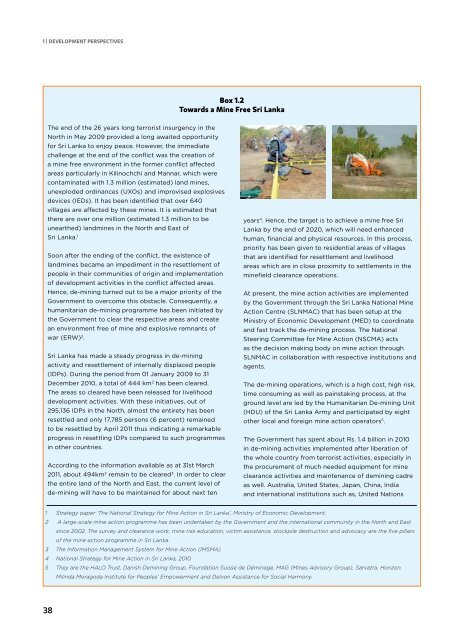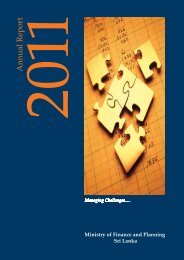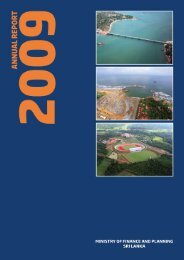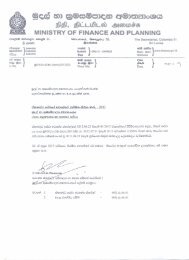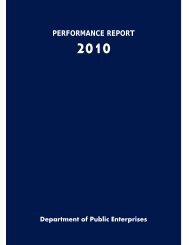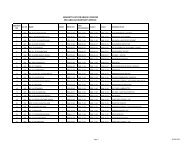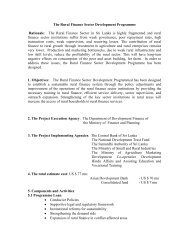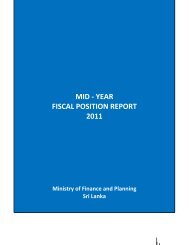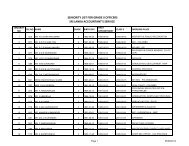Annual Report 2010 - Ministry of Finance and Planning
Annual Report 2010 - Ministry of Finance and Planning
Annual Report 2010 - Ministry of Finance and Planning
Create successful ePaper yourself
Turn your PDF publications into a flip-book with our unique Google optimized e-Paper software.
1 | DEVELOPMENT PERSPECTIVESBox 1.2Towards a Mine Free Sri LankaThe end <strong>of</strong> the 26 years long terrorist insurgency in theNorth in May 2009 provided a long awaited opportunityfor Sri Lanka to enjoy peace. However, the immediatechallenge at the end <strong>of</strong> the conflict was the creation <strong>of</strong>a mine free environment in the former conflict affectedareas particularly in Kilinochchi <strong>and</strong> Mannar, which werecontaminated with 1.3 million (estimated) l<strong>and</strong> mines,unexploded ordinances (UXOs) <strong>and</strong> improvised explosivesdevices (IEDs). It has been identified that over 640villages are affected by these mines. It is estimated thatthere are over one million (estimated 1.3 million to beunearthed) l<strong>and</strong>mines in the North <strong>and</strong> East <strong>of</strong>Sri Lanka. 1Soon after the ending <strong>of</strong> the conflict, the existence <strong>of</strong>l<strong>and</strong>mines became an impediment in the resettlement <strong>of</strong>people in their communities <strong>of</strong> origin <strong>and</strong> implementation<strong>of</strong> development activities in the conflict affected areas.Hence, de-mining turned out to be a major priority <strong>of</strong> theGovernment to overcome this obstacle. Consequently, ahumanitarian de-mining programme has been initiated bythe Government to clear the respective areas <strong>and</strong> createan environment free <strong>of</strong> mine <strong>and</strong> explosive remnants <strong>of</strong>war (ERW) 2 .Sri Lanka has made a steady progress in de-miningactivity <strong>and</strong> resettlement <strong>of</strong> internally displaced people(IDPs). During the period from 01 January 2009 to 31December <strong>2010</strong>, a total <strong>of</strong> 444 km 2 has been cleared.The areas so cleared have been released for livelihooddevelopment activities. With these initiatives, out <strong>of</strong>295,136 IDPs in the North, almost the entirety has beenresettled <strong>and</strong> only 17,785 persons (6 percent) remainedto be resettled by April 2011 thus indicating a remarkableprogress in resettling IDPs compared to such programmesin other countries.According to the information available as at 31st March2011, about 494km 2 remain to be cleared 3 . In order to clearthe entire l<strong>and</strong> <strong>of</strong> the North <strong>and</strong> East, the current level <strong>of</strong>de-mining will have to be maintained for about next tenyears 4 . Hence, the target is to achieve a mine free SriLanka by the end <strong>of</strong> 2020, which will need enhancedhuman, financial <strong>and</strong> physical resources. In this process,priority has been given to residential areas <strong>of</strong> villagesthat are identified for resettlement <strong>and</strong> livelihoodareas which are in close proximity to settlements in theminefield clearance operations.At present, the mine action activities are implementedby the Government through the Sri Lanka National MineAction Centre (SLNMAC) that has been setup at the<strong>Ministry</strong> <strong>of</strong> Economic Development (MED) to coordinate<strong>and</strong> fast track the de-mining process. The NationalSteering Committee for Mine Action (NSCMA) actsas the decision making body on mine action throughSLNMAC in collaboration with respective institutions <strong>and</strong>agents.The de-mining operations, which is a high cost, high risk,time consuming as well as painstaking process, at theground level are led by the Humanitarian De-mining Unit(HDU) <strong>of</strong> the Sri Lanka Army <strong>and</strong> participated by eightother local <strong>and</strong> foreign mine action operators 5 .The Government has spent about Rs. 1.4 billion in <strong>2010</strong>in de-mining activities implemented after liberation <strong>of</strong>the whole country from terrorist activities, especially inthe procurement <strong>of</strong> much needed equipment for mineclearance activities <strong>and</strong> maintenance <strong>of</strong> demining cadreas well. Australia, United States, Japan, China, India<strong>and</strong> international institutions such as, United Nations1 Strategy paper ‘The National Strategy for Mine Action in Sri Lanka’, <strong>Ministry</strong> <strong>of</strong> Economic Development.2 A large-scale mine action programme has been undertaken by the Government <strong>and</strong> the international community in the North <strong>and</strong> Eastsince 2002. The survey <strong>and</strong> clearance work, mine risk education, victim assistance, stockpile destruction <strong>and</strong> advocacy are the five pillars<strong>of</strong> the mine action programme in Sri Lanka.3 The Information Management System for Mine Action (IMSMA)4 National Strategy for Mine Action in Sri Lanka, <strong>2010</strong>5 They are the HALO Trust, Danish Demining Group, Foundation Suisse de Déminage, MAG (Mines Advisory Group), Sarvatra, Horizon,Milinda Moragoda Institute for Peoples’ Empowerment <strong>and</strong> Delvon Assistance for Social Harmony.38


